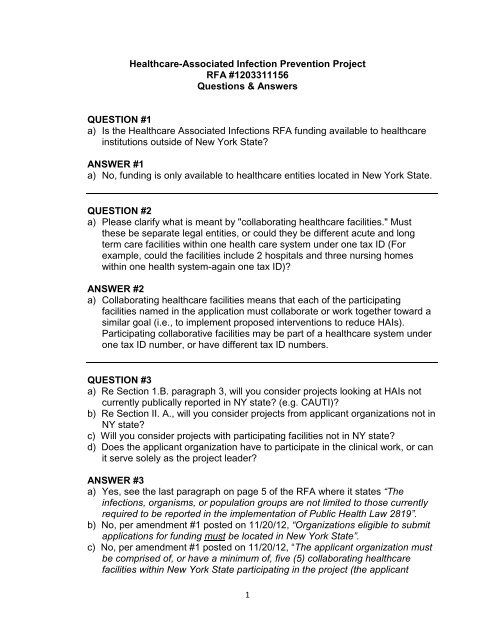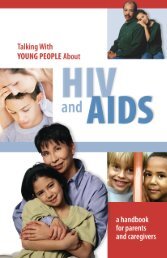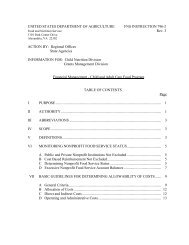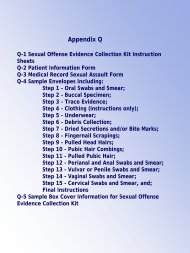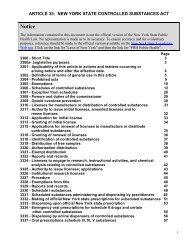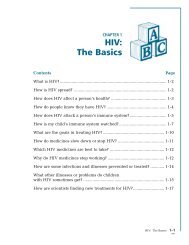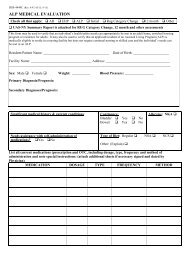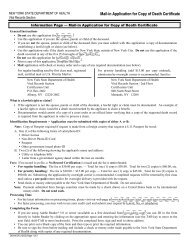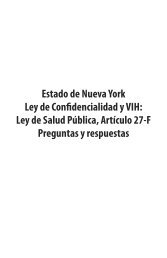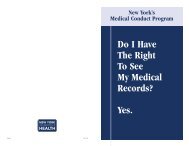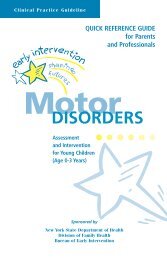Questions and Answers - New York State Department of Health
Questions and Answers - New York State Department of Health
Questions and Answers - New York State Department of Health
You also want an ePaper? Increase the reach of your titles
YUMPU automatically turns print PDFs into web optimized ePapers that Google loves.
<strong>Health</strong>care-Associated Infection Prevention Project<br />
RFA #1203311156<br />
<strong>Questions</strong> & <strong>Answers</strong><br />
QUESTION #1<br />
a) Is the <strong>Health</strong>care Associated Infections RFA funding available to healthcare<br />
institutions outside <strong>of</strong> <strong>New</strong> <strong>York</strong> <strong>State</strong>?<br />
ANSWER #1<br />
a) No, funding is only available to healthcare entities located in <strong>New</strong> <strong>York</strong> <strong>State</strong>.<br />
QUESTION #2<br />
a) Please clarify what is meant by "collaborating healthcare facilities." Must<br />
these be separate legal entities, or could they be different acute <strong>and</strong> long<br />
term care facilities within one health care system under one tax ID (For<br />
example, could the facilities include 2 hospitals <strong>and</strong> three nursing homes<br />
within one health system-again one tax ID)?<br />
ANSWER #2<br />
a) Collaborating healthcare facilities means that each <strong>of</strong> the participating<br />
facilities named in the application must collaborate or work together toward a<br />
similar goal (i.e., to implement proposed interventions to reduce HAIs).<br />
Participating collaborative facilities may be part <strong>of</strong> a healthcare system under<br />
one tax ID number, or have different tax ID numbers.<br />
QUESTION #3<br />
a) Re Section 1.B. paragraph 3, will you consider projects looking at HAIs not<br />
currently publically reported in NY state? (e.g. CAUTI)?<br />
b) Re Section II. A., will you consider projects from applicant organizations not in<br />
NY state?<br />
c) Will you consider projects with participating facilities not in NY state?<br />
d) Does the applicant organization have to participate in the clinical work, or can<br />
it serve solely as the project leader?<br />
ANSWER #3<br />
a) Yes, see the last paragraph on page 5 <strong>of</strong> the RFA where it states “The<br />
infections, organisms, or population groups are not limited to those currently<br />
required to be reported in the implementation <strong>of</strong> Public <strong>Health</strong> Law 2819”.<br />
b) No, per amendment #1 posted on 11/20/12, “Organizations eligible to submit<br />
applications for funding must be located in <strong>New</strong> <strong>York</strong> <strong>State</strong>”.<br />
c) No, per amendment #1 posted on 11/20/12, “The applicant organization must<br />
be comprised <strong>of</strong>, or have a minimum <strong>of</strong>, five (5) collaborating healthcare<br />
facilities within <strong>New</strong> <strong>York</strong> <strong>State</strong> participating in the project (the applicant<br />
1
organization may or may not count as one).” Also see answer to Question<br />
#3b above.<br />
d) The applicant organization does not have to participate in the clinical work but<br />
must have a collaborative relationship with the participating facilities to ensure<br />
adequate monitoring <strong>and</strong> oversight <strong>of</strong> required activities <strong>and</strong> outcome<br />
measures.<br />
QUESTION #4<br />
a) Do long term care facilities qualify for this RFA <strong>and</strong> can be counted as one <strong>of</strong><br />
the facilities?<br />
ANSWER #4<br />
a) Yes, long term care facilities are a qualifying applicant, <strong>and</strong> can also be<br />
counted as a participating facility.<br />
QUESTION #5<br />
a) Can you please define the term “healthcare facilities” on pg. 4, section II. Who<br />
May Apply, second bullet, first sentence?<br />
ANSWER #5<br />
a) NYSDOH does not specifically define the term “healthcare facility”. For the<br />
purposes <strong>of</strong> this RFA, “healthcare facility” is intended to apply to any not-forpr<strong>of</strong>it<br />
facility that directly provides healthcare to patients as a primary function.<br />
<strong>Health</strong>care facilities may include, but are not limited to, hospitals, nursing<br />
homes, dialysis centers, <strong>and</strong> ambulatory surgery centers.<br />
QUESTION #6<br />
a) Does the funding opportunity above have a geographic restriction to NY<br />
<strong>State</strong>? If so, would including one NY hospital be enough, or should all health<br />
care facilities be in the NY <strong>State</strong>?<br />
ANSWER #6<br />
a) Yes, per amendment #1 posted on 11/20/12, “The applicant organization<br />
must be comprised <strong>of</strong>, or have a minimum <strong>of</strong>, five (5) collaborating healthcare<br />
facilities within <strong>New</strong> <strong>York</strong> <strong>State</strong> participating in the project (the applicant<br />
organization may or may not count as one).” Therefore, all participating<br />
healthcare facilities must be located within <strong>New</strong> <strong>York</strong> <strong>State</strong>.<br />
2
QUESTION #7<br />
a) Re: the requirement that the project leadership team must include persons<br />
with experience in conducting epidemiologic research, surveillance, <strong>and</strong><br />
infection control. If one member is certified in infection control (CIC) can the<br />
other members be nurses or medical staff that currently work in infection<br />
control roles at each facility?<br />
b) What level <strong>of</strong> “experience” is needed for the other team members?<br />
c) Does the individual with the infection control certification have to be a staff<br />
member <strong>of</strong> the one <strong>of</strong> the facilities participating in the grant, or can that<br />
individual be a contracted employee from a larger facility outside our network<br />
(not partnering on the grant)?<br />
d) Do the individuals on the leadership team with experience in conducting<br />
epidemiologic research, surveillance, <strong>and</strong> infection control <strong>and</strong> with infection<br />
control certification have to be staff members <strong>of</strong> one <strong>of</strong> the facilities<br />
participating in the grant, or can that individual be a contracted employee<br />
(contracted for the purpose <strong>of</strong> carrying out this grant) <strong>and</strong> therefore outside<br />
our network (i.e., the contracted employee would not be a staff member at<br />
one <strong>of</strong> the healthcare facilities partnering on the grant)?<br />
e) On pages 13-14, the program summary/overview <strong>and</strong> components sections <strong>of</strong><br />
the application are described. Do these sections have to be organized by<br />
grant year, one through five or can these sections be written in a general<br />
sense for the entirety <strong>of</strong> the grant?<br />
f) On page 18, the RFA states, “Describe your organization’s<br />
policies/procedures to ensure the needs <strong>of</strong> racial/ethnic minorities <strong>and</strong><br />
persons with disabilities are met.” Is it sufficient to have a statement in the<br />
lead organization’s bylaws as opposed to a specific policy/procedure?<br />
g) If the lead organizations does not have any organizational policies <strong>and</strong><br />
procedures given they do not employ staff <strong>and</strong> are a st<strong>and</strong>-alone not for pr<strong>of</strong>it<br />
organization, can the participating healthcare facilities’ policies/procedures be<br />
used to meet this criteria?<br />
ANSWER #7<br />
a) Yes, other members (who may or may not be certified in infection control) <strong>of</strong><br />
the project leadership team can be nurses or medical staff that currently work<br />
in infection control roles at each facility. Per section II. A. <strong>of</strong> the RFA (pg. 5),<br />
“The project leadership team must include persons with experience in<br />
conducting epidemiologic research, surveillance, <strong>and</strong> infection<br />
control…..documented by attaching curricula vitae for these leadership team<br />
members.”<br />
b) As stated above, the project leadership team must include persons with<br />
experience in conducting epidemiologic research, surveillance, <strong>and</strong> infection<br />
control. It is important that team members have the requisite experience<br />
commensurate with their roles <strong>and</strong> responsibilities outlined in the application.<br />
c) The Individual with infection control certification (CIC) on the leadership team<br />
does not need to be a staff member <strong>of</strong> one <strong>of</strong> the participating facilities <strong>and</strong><br />
can be a contracted employee from outside the network. As a member <strong>of</strong> the<br />
3
leadership team, the CIC-credentialed member should have an active role in<br />
the project. Please note, CIC credentials are a preferred qualification.<br />
d) Other members <strong>of</strong> the leadership team (including the member with CIC) do<br />
not need to be staff members <strong>of</strong> one <strong>of</strong> the participating facilities <strong>and</strong> can be<br />
contracted employees from outside the network. All members <strong>of</strong> the<br />
leadership team should have an active role in the project.<br />
e) The program summary/overview <strong>and</strong> components sections <strong>of</strong> the application<br />
should include concrete plans for year 1. Contingent plans for years 2-5 may<br />
be combined <strong>and</strong> summarized.<br />
f) Yes.<br />
g) Yes, as long as the policies <strong>and</strong> procedures <strong>of</strong> the participating facilities are<br />
described <strong>and</strong> will be followed by the lead organization.<br />
QUESTION #8<br />
a) Can separate <strong>and</strong> distinct hospitals under the umbrella <strong>of</strong> a health care<br />
system <strong>and</strong> all sharing the same hospital operating certificate number be<br />
considered eligible partners in the required five collaborating facilities if the<br />
health care system is the applicant?<br />
b) Are skilled nursing facilities eligible partners?<br />
ANSWER #8<br />
a) Yes.<br />
b) Yes.<br />
QUESTION #9<br />
a) Do 10% indirect costs come out <strong>of</strong> total or are the IDC in addition to the stated<br />
fund amounts?<br />
b) Is there a salary cap?<br />
c) Is a cost <strong>of</strong> living increase okay?<br />
d) Can a university affiliated physician be the PI representing hospital?<br />
e) Is in-kind salary support okay?<br />
f) What format should CV’s be in? Should we use NIH biosketch or other?<br />
g) Who are considered the institutions: can this be hospital sites + university<br />
sites?<br />
h) Is it permissible to use existing tools, e.g., checklists?<br />
i) Will NYS DOH team be involved in publications?<br />
ANSWER #9<br />
a) The 10% indirect costs come out <strong>of</strong> the total award.<br />
b) Yes, per Executive order 38 (http://www.governor.ny.gov/executiveorder/38),<br />
“<strong>State</strong> financial assistance or <strong>State</strong>-authorized payments shall not be<br />
provided for compensation paid or given to any executive by such provider in<br />
an amount greater than $199,000 per annum”. Also, proposed salaries should<br />
be reasonable (usual <strong>and</strong> customary for the services provided in the region).<br />
4
c) Yes. Also, if a cost <strong>of</strong> living increase is requested for staff in years 2-5, the<br />
increase should be justified in attachment #3.<br />
d) Yes.<br />
e) Yes.<br />
f) There is no prescribed format for CV’s.<br />
g) Institutions that can serve as a collaborating healthcare facility may be both<br />
hospital sites <strong>and</strong>/or university sites as long as they meet the definition <strong>of</strong><br />
“healthcare facilities” provided in question 5.<br />
h) Yes.<br />
i) NYSDOH may or may not be involved in contributing to publications related to<br />
the funded projects. Per Appendix A-2 (attachment #5), NYSDOH must<br />
review the final draft <strong>of</strong> the publication before it is submitted to a peer review<br />
committee.<br />
QUESTION #10<br />
a) Do applicants need to have every hospital they would be working with<br />
committed upon submission <strong>of</strong> the application, or could the applicant get an<br />
approximate number <strong>of</strong> institutions that would be committed to working on the<br />
initiative?<br />
b) Along the same lines, if we were to form a Clinical Advisory Group for the<br />
project we propose, would we need to have commitment from all <strong>of</strong> the<br />
clinical experts who would be involved upon submission <strong>of</strong> the application, or<br />
could the applicant get an estimation <strong>of</strong> who would be on the Clinical Advisory<br />
Group?<br />
ANSWER #10<br />
a) No, signed letters <strong>of</strong> agreement from participating facilities must be included<br />
with the application for funding (see RFA pg. 5, second bullet).<br />
b) If your clinical advisory group is also your project leadership team, then you<br />
will need to list the members (<strong>and</strong> their experience) in attachment #1. If the<br />
clinical advisory group is separate from the project leadership team, then you<br />
do not need to provide evidence <strong>of</strong> a commitment from its members.<br />
5


